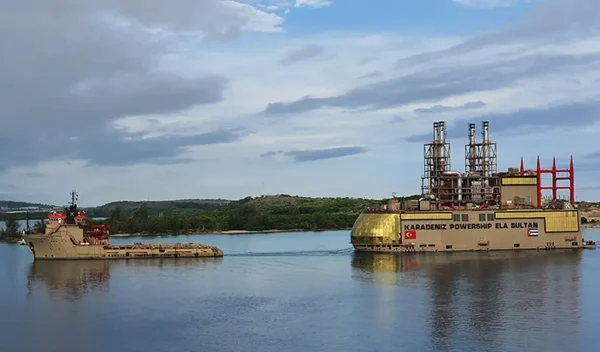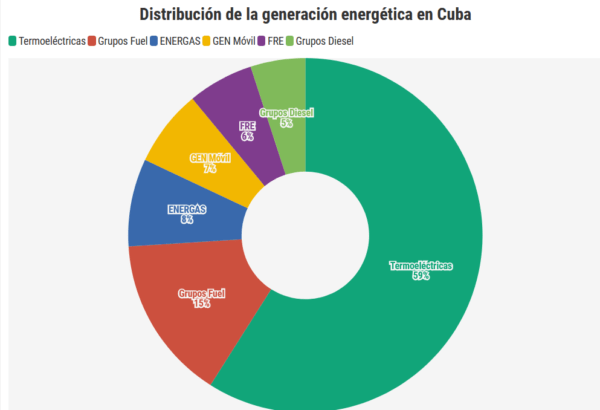Turkish Powerships in Cuba, a Plan We Know Little About

HAVANA TIMES – In mid-November, news broke of the arrival of the seventh floating powership, contracted from Turkey in Cuba. This has been a frequent piece of news in recent months and has been used as a glimpse of hope for the Cuban people who have been suffering a long period of blackouts. However, electricity cuts – especially in the country’s interior – are eight-hours long every day, and can even reach 15 hours in some parts.
The Cuban Government insists on covering up as much information as they can about the subject, calling it a “strategic” affair, but a lot of questions have been asked.
El Toque has summarized the little that has been published about Turkish powerships and the conditions of their operations in Cuba.
What is a floating power plant?
It is a ship that has one or various electricity generators, using either fuel oil or heavy fuel oil (residual fuel incurred during the distillation of crude oil with a high-sulphur content), and is a cheaper alternative.
Floating power plants are transported on ships or tow barges. They are normally placed near power plants, whether they are active or not, to make the most of these plants’ substations and networks – such as Mariel and Tallapiedra in Havana.
When did powerships arrive in Cuba?
The contract to “deploy” the first powerships in the country was signed in October 2018, between Energoimport (Cuba’s state-led company for electricity generation, transmission and distribution equipment) and Karpowership (subsidiary for naval operations belonging to Karadeniz Holding), a business group specializing in electricity generation, with its head offices in Istanbul.
The initial agreement planned for three of these powerships to provide services for 51 months – just over four years – feeding 110 MW of power to the National Grid (SEN).
The first two powerships anchored in Mariel Bay and joined the SEN in June 2019. The rest were added to the network, five months later.
Since then, the contract has been renegotiated twice: in November 2019, to increase power to 144 MW; and in November 2021, when the agreed power supply was increased to 300 MW and the duration of the contract was extended to 18 years. On November 15, 2022, a new barge arrived in Cuba with an electricity generation capacity of 110 MW, which would increase the contracted energy to 500 MW.
When the first powership arrived in Cuba, another nine countries – mostly in Asia and Africa – had contracts with the Turkish company; but the Caribbean country was their first client in Latin America.
Who is Karpowership and how do they operate?
In the past decade, Turkey became a leading operator in this kind of technology under Karpowership, an expert in “wooing Governments desperate for electricity.”
The Center for Investigative Reporting “Ama Bhungane”, from South Africa, attributes this phrase to Orhan Karadeniz, the executive director of Karpowership. Along with Libya and Iraq, South Africa is one of the company’s main clients, purchasing 12,220 MW of electricity in July 2021.
Since 2011, Karpowership’s global flotilla capacity has practically sextupled, exceeding 4,100 MW of power, with plans to add another 4,400 MW in the future. Between 2014 and 2019, its revenue went from over 400 million to 1.1 billion per year, Ama Bhungane explains, who was able to access the company’s bank statements.
The Turkish Government has been actively promoting this growth. “The company tends to travel in the wake of President Tayyip Erdogan’s diplomatic trips, acting as a kind of national champion with all of the political backing that this involves,” the journalistic investigation adds.
This was what happened in Libya, in May 2020, when an agreement to provide 1,000 MW was announced after Erdogan’s trip to Tripoli, or in Haiti, where the Turkish leader and his counterpart Jovenel Moïse had spoken on the phone about the possibility of installing floating power plants, shortly before his assassination.
In 2018, Karpowership even tried to expand to more developed countries’ markets, with an agreement to provide Belgium with 900 MW to make up for the energy deficit caused by the closure of one of its nuclear reactors. “The fact that the company’s powerships […] reached Belgian ports within 20 days plays an important role in negotations,” national Turkish TV pointed out.
According to information available in some countries, Karpowership has sold fuel to power plants itself, thereby getting a third of the company’s income.
Why has Cuba leased Turkish powerships?
First of all, because of time. It takes four or five years of investment to set up a thermoelectric power plant, Cuban President Miguel Diaz-Canel explained in June. “That’s why we’ve turned to mobile electricity generation plants in the past two years, a businees where we rent the barge and we immediately have electricity generation. It isn’t a time-consuming investment.”
Good bilateral relations with Ankara are another compelling reason to create closer ties with Karpowership. During his latest meeting with Diaz-Canel, Turkish President Recep Tayyip Erdogan guaranteed he’d give “special importance to increasing cooperation and solidarity with Cuba.” His Government’s immediate objectives are to increase bilateral trade to 200 million USD per year and to reinforce Turkey’s presence in Cuba’s energy, tourism and agricultural sectors.

How much do Turkish powerships cost?
In the absence of official data, any estimate has to stem from assessments published by the company itself. After consulting them, CIR Ama Bhungane concluded that in 2019, Karadeniz Holding had received a revenue of 1.095 billion USD, for the production of 4100 MW from the power plants. In other words, every megawatt of power brought in US $267,000 for the company annually.
In accordance with these calculations, the company could be charging Cuba approximately 106 million USD per year for its electricity generation capacity to the island.
In Cuba’s case, we also have the contract signed by the Turkish company and the South African Government as a reference, which committed Pretoria to paying between 550-990 million USD per year for the use of 1220 MW from powerships. The difference in these invoices comes from the level of development of these plants. This is to ensure a “minimum” income for the company. If Cuba conformed to these tariffs, they would have to pay between 226-334 million USD per year.
Of course, Cuba could be paying – or pay in the future – part of the sevice of these powerships with concessions they’ve made in other sectors of interest to the Turkish company.
What is the environmental impact of these powerships?
In November 2021, the technical director of the Electricity Union, Lazaro Guerra Hernandez, told Granma that the powership introduced in Tallapiedra “meets every environmental standard in terms of gas emissions, noise and possible vibrations.”
His statement appeared to come to relieve the concerns of the neighboring community, which has historically been a victim of pollution created by the “Otto Parellada” power plant. The advantage of the Turkish industry was proven in July when the Otto Parellada plant worked for a few days, amidst a deafening noise and a thick plume of smoke that went up into the air.
Powerships anchored in Mariel are so far away from the urban area that the local population can’t even pick up on its impact.
However, electricity generation with diesel or fuel oil turbines – such as those used by Karpowership – is a lot more costly in environmental terms than a power plant or electricity generation using gas turbines. This was proven in a comparative study carried out in Cienfuegos, in 2014.
There were steep differences in variables such as global warming and the use of water in comparison to distributed generation, especially because they use fuel that require a greater degree of industrial refining. The investigation didn’t take into account the performance of power plants that use crude oil – the Carlos Manuel de Cespedes plant that operates with fuel oil – which could have recorded a greater advantage with electricity generators.
The environmental impact of Karpowership’s plants is still being discussed in countries such as South Africa, where a court will decide in early 2023 if Turkish ships are allowed to dock in three of the country’s ports. Permits had been frozen after environmental organizations complained about the toxic effects of its activity on small-scale fishing and marine ecosystems, in addition to the negative impact on climate change.
Up until now, the Cuban Ministry of Science, Technology and Enviroment (CITMA) hasn’t published an analysis of the impact of these Turkish powerships. Nor are there any signs that they will be doing this in the near future.
In a situation where these industries are vital to maintaining the country’s demand for electricity, any consideration that might hinder their operations seems inappropriate. At least, from the Government’s perspective.
How much electricity are Turkish powerships providing?
According to Cubadebate, electricity generated by these powerships surpassed 400 MW for the first time once the seventh barge arrived.
“In 2023, it is expected that floating power plants will provide 18-20% of electricity generation in Cuba,” according to a news feature on Cuban State TV.
Last year, powerships contributed only 7% to national electricity generation. No other technology has grown so quickly in capacity, out of all the ones that operate on the archipelago.
However, in order to cover the actual electricity generation deficit in peak hours – which oscillates between 900-1200 MW per day -, Cuba would need to install at least another five or seven barges, as demand today is still above the amount of electricity being generated.
Turkish powerships are a fast alternative to ease the energy crisis we’re seeing in the country today. However, questions about the lease and payment contracts between the Government and Turkish company have still been left unanswered.
This goes hand-in-hand with the risks of investing in a short-term solution that will mean it takes longer to invest in the energy sector. An investment that has dropped by over 4% between 2018-2021, according to the Cuban Office of Statistics: from 11.44% to 7.2%.
The Government announced that it would need 200 million USD, according to its calculations, to repair existing power plants. However, the budget for the energy sector is being spent on powerships or distributed generation equipment. This short-term strategy might provide some relief to blackouts today, but it won’t stop blackouts from making headlines again anytime in the near future, just like it has in the past 30 years. How the Cuban Government is planning to guarantee and develop the country’s main sources of electricity generation is still unknown.
